Moray Eel
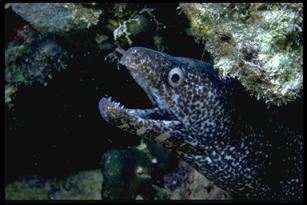
Spotted Moray Eel
Moray eels are scaleless saltwater fish that belong to the family Muraenidae. They have snake-like elongated bodies, and they swim by moving their body from side to side. They also have very sharp teeth. Because of their appearance they are sometimes called sea monsters.
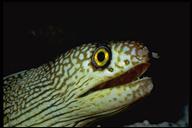
Golden-eye Moray Eel
Despite their sharp teeth and fierce appearance, moray eels rarely attack humans unless provoked, or unless they mistake an aquarist's hand for food. Moray eels have a highly developed sense of smell, but poor eyesight. Morays do sometimes bite their aquarist's hands and these bites frequently get infected.
There are many different species and genera of moray eels that are commonly kept in home aquaria: Echidna, Gymnothorax, Rhinomuraena, Enchelycore, and Gymnomuraena spp. There are 15 genera and over 200 species overall.
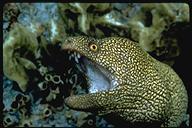
Goldentail Moray Eel
Moray eels grow quite large. Species most commonly kept in captivity range from about 12.6 inches (32 cm) to 60 inches (152 cm) in length. Other species of moray eels are generally too large to be kept in the home aquarium. Some reach a size of 13 feet (4 m).
Although many moray eels that are 4-5 feet (122-152 cm) in length are commonly kept in the home aquaria, the list below includes some of the smaller moray eel species:
- Richardson's Moray (Gymnothorax richardsonii) - 12.6 inches (32 cm)
- Chestnut Moray (Enchelycore carychoa) - 13.4 inches (34 cm)
- Trunk-eyed Moray (Gymnothorax margaritophorus) - 14 inches (36 cm)
- Whitelip Moray (Gymnothorax chilospilus) - 19.7 inches (50 cm)
- Dark-spotted Moray (Gymnothorax rueppelliae) - 21.7 inches (55 cm)
- Banded Moray (Echidna polyzona) - 23.6 inches (60 cm)
- Goldentail Moray (Gymnothorax miliaris) - 23.6 inches (60 cm)
- White-eye Moray (Gymnothorax thyrsoidea) - 25.6 inches (65 cm)
- Chainlink Moray (Echidna catenata) - 28 inches (71 cm)
- Snowflake Moray (Echidna nebulosa) - 29.5 inches (75 cm)
The snowflake eel is reported to be one of the easiest eels to keep in captivity.
In their natural environment morays eat crustaceans, invertebrates, and small fish. They are nocturnal fish and usually hide in crevices in coral reefs and wait for prey to pass by. You must keep both their size and their predatory nature in mind when choosing their tank and tankmates. However, don't get the idea that moray eels are mean fish - they aren't - they are only trying to have dinner just like you and I do. Morays will eat any fish that will fit into their mouths, although they don't swallow their food whole like snakes do.
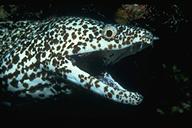
Spotted Moray Eel
Fish that moral eels may be compatible with are:
- Large angelfish
- Boxfish
- Groupers (although sometimes large groupers prey on moray eels)
- Lionfish
Moray eels are not suitable for reef tanks or tanks that house invertebrates or small fish. However, they can be kept with some corals. Large moray eels often prey on smaller eels. Also, moray eels sometimes escape from their aquarium and so you'll need a tight fitting lid.
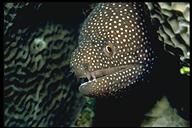
White-spotted Moray Eel
Some moray eels also secrete a toxin in their skin.
They are carnivores and in captivity you can feed your moray eel fresh and frozen (thawed) fish, squid, crustaceans, or other meaty foods.
At first, moray eels may be reluctant to eat in captivity because they are used to eating only live foods. You can encourange your eel to eat by using a feeding stick and waving the food around to produce movement. You can also try giving it live feeder fish. Don't attempt to handfeed your eel or it may accidentally bite you.
Spawning doesn't typically occur in the home aquarium.
Prices for moray eels generally range from $24-400 depending on the species and size.
Moray eels have long life-spans. There are reports of moray eels living in captivity for almost 30 years.
